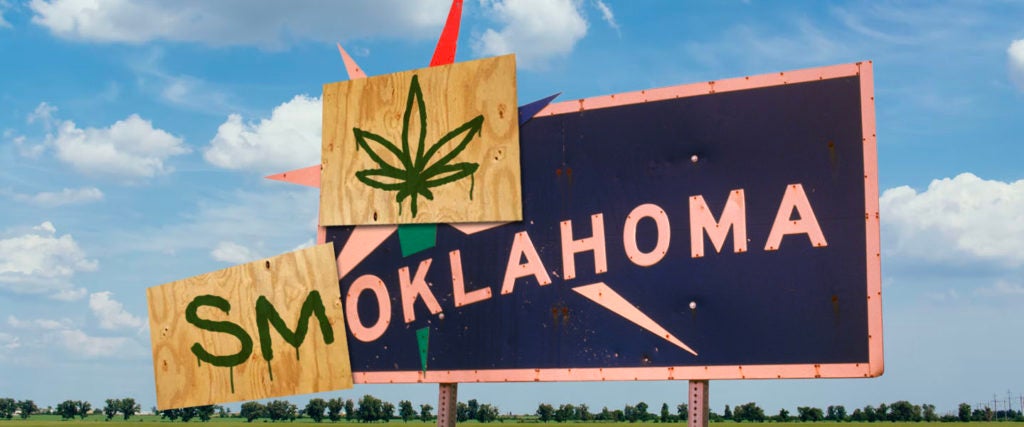Oklahoma is overrun with marijuana — and state officials are scrambling to figure out what to do about it.
The state used to be one of the most restrictive when it came to recreational drugs, with a reputation for levying heavy jail and prison time for possessing pot. That changed in a big way with a milestone 2018 law that made medical marijuana legal in the Sooner State.
Seemingly overnight, Oklahoma became an epicenter of new weed businesses, soaring high off the promise of cheap land, eager consumers and the state’s famously hands-off, pro-business government culture. Which lands us here, three years later, with county sheriffs and legislators increasingly concerned about illegal grows, farms run by foreign nationals, gunfights and stolen water.
Consider Oklahoma the new Wild West of Weed — and an allegory for the chaos that unfolds when the pressures of past prohibition collide with capitalist hustle in a free-for-all.
Today, Oklahoma has upwards of 9,000 licensed marijuana operations, including some 2,000 dispensaries and nearly 6,000 grow houses. (For comparison, stereotyped stoner paradise Colorado has about half the number of pot shops for a population that’s 50 percent bigger than that of Oklahoma.) It’s incredibly simple to obtain a license to sell marijuana there, unlike in other states that have more complex zoning and planning requirements, and it costs just $2,500 up front. As marijuana entrepreneur (and Oklahoma weed market evangelist) Chip Baker has noted, the lack of regulation, bureaucracy and expenses means that the barrier to entry in the state is lower than it is in a place like California.
“Oklahoma is a business-first state. The oil, gas and ranching industry made it that way. For good or bad, you can pretty much start up any business you want here and people won’t give you hassle over it,” Baker said on the Green Entrepreneur podcast.
The timing was apparently perfect, too: Some 300,000 Oklahomans signed up for medical marijuana cards when the law was first passed, Baker noted. Today, there are nearly 380,000 licensed consumers in the state. It also raked in $66 million in tax revenue in 2020, with the number only set to increase in future years.
So much for the cultural divide: Despite Oklahoma’s reputation as a deep-red state with conservative values around recreational drug use, the reality there seems to mirror broader American support for marijuana. In fact, despite only medical marijuana being legal in the state, experts suggest it’s a de-facto recreational market, given the ease of acquiring a consumer license regardless of what kind of medical condition you claim to have. “Everybody likes weed — even conservative people. Just because they go to church on Sunday doesn’t mean they don’t smoke weed before they go to church on Sunday. … As soon as it becomes legal, peoples’ idea of it all changes,” Baker concluded on the podcast. “Now it’s not against the law, so they don’t care, they speak out.”
There’s a kind of sick irony in the tide turning so swiftly, especially considering the long and racist history of Oklahoma locking people up for pot. Hundreds of people have been imprisoned every year in the state for low-level, non-violent drug offenses; even by national standards, the punishment for breaking drug laws was disproportionately tough, with long sentences given out to anyone suspected of trying to sell.
But with pot becoming a socially acceptable way to generate profit, the gloves are off and Oklahoma is feeling the full force of capitalist fervor, for better and for worse. Despite the low barrier to entering Oklahoma’s legal weed scene, residents and cops keep claiming to find illegal operations that are behaving dangerously. Growers from around the world are buying up property en masse, often paying above asking prices with cash, inflating the real estate market and shutting locals out. By some accounts, Oklahoma is now officially a hub of illegal weed for the rest of the country.
Is Oklahoma a cautionary tale of libertarian ideals? A green utopia where the fittest businesses can survive and thrive? Or perhaps an indictment of how lingering federal prohibition leads to more problems than effective policy?
Three years after it legalized medical marijuana, the answer seems to simply be “yes,” and it reminds me of what Kim Foxx, state’s attorney in Cook County, Illinois, told me when I asked her earlier this year whether a free-for-all approach to legalization may be the quickest way toward correcting the mistakes of the past. A staunch advocate for drug-policy reform and decriminalization, Foxx noted that it’s “very early to tell” with a state like Oklahoma, but cautioned against what can happen when legalization efforts get chaotic.
“We ought to phase things and observe, research and analyze as we expand. A free-for-all without any measure of qualitative analysis might be problematic. If we over-correct by letting anything go, then we might have to one day correct in the opposite direction — and people are always waiting to say, ‘See, it was a colossal failure,’” Foxx said. “I think we can ease into something without going full tilt, because the backlash can be big if you don’t.”
It just goes to show that big things happen when we strip away the cumbersome prohibition that hurt so many people in America — and it’ll take time for all the trailing effects to unravel. Oklahoma chose a philosophy of anything goes, and it may be a blueprint for many other “pro-business” Republican states that want to try their hand at growing America’s trendiest cash crop. “We will be one of the epicenters of ganja in the country soon. I know people like to joke about it. Give it a couple years, and the dankest weed in the country will be grown here,” Baker said.
That’s not hard to believe, given the green rush unfolding there. But in the Wild West of American pot, it’s not about the quality of the grow — it’s about who gets to profit, and for how long.

